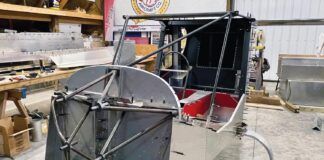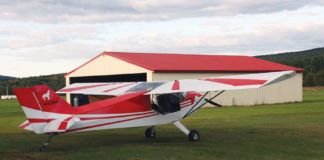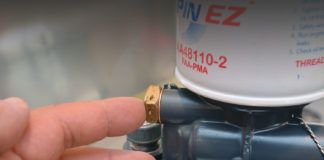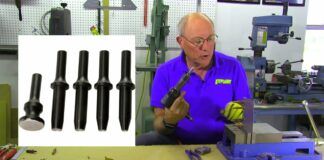Welcome to Part 2 of our discussion on aircraft aluminum, the first part of which appeared in the March 2012 issue. This time, using specific examples, we’ll look further into sheet metal repairs.—Ed.
Consider the following scenario: Despite your best efforts to avoid it, you’ve struck a bird with your airplane. Fortunately, the damage doesn’t seem to affect the airplane’s flying characteristics. You head for home and land, and find a bird-size dent in the leading edge of one wing. What now? Sometimes a simple repair is in order, but you’ll achieve faster and more satisfactory results by replacing the damaged skins. Regardless of which method you choose, here are some tips on how to proceed.
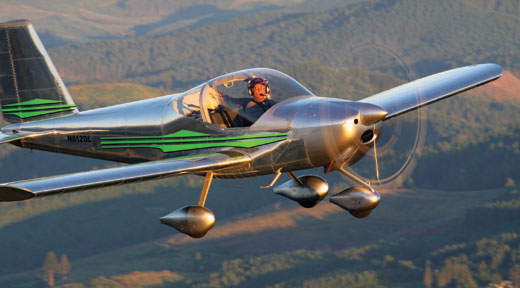
There you are, enjoying your flight on a sunny day, and Bam! A bird strike. It didn’t happen here, thankfully, but it might have. So then what do you do?
Inspect for Further Damage
Conduct a thorough inspection of all associated structures for additional damage. In the case of wing leading-edge damage, look closely at all wingskins for signs of distortion, rippling or waviness. Open inspection panels and investigate. Any abnormal impact force to a wing’s leading edge can damage or distort the structure. As you look for skin distortion, be sure to check the rear wing attach point. You can always compare the damaged wing to the undamaged wing to get a sense of whether anything is amiss.
Any time an airframe is damaged I recommend owners enlist the help of an experienced airframe mechanic or sheet-metal technician to evaluate the extent of the damage. Part of the assessment should include contacting the kit manufacturer and describing the damage. Send high-definition digital photos, if asked.

Should you encounter damage to the leading edge of your wing, a thorough inspection must be done to determine the extent of the damage, including looking for skin distortion or structural damage.
Tap, Fill and Paint
The simplest dent repair involves tapping out the dent, filling it with lightweight auto-body filler (Bondo) and painting it over. To do this, you’ll need to gain access to the backside of the leading edge and gently tap the damaged area back into alignment; a rounded wood dowel can help. Enlist someone to hold a piece of wood or a sand bag against the outside of the wing leading edge while you gently tap the damaged area from the inside. Don’t push the dented skin too far while tapping, and don’t get into a tap-a-thon attempting to make the surface perfectly smooth—it’s impossible to return stretched aluminum to its pre-stretched condition. Less is better. Every time a piece of aircraft aluminum is bent it becomes more brittle. This is called “work hardening.”
The tap, fill and paint option is an acceptable repair as long as the impact damage is light and didn’t cause rib damage or occur in the vicinity of a rib.
If the bird impact damaged a wing nose rib or additional structure, the repair becomes more complex. A thorough study will have to be conducted to determine if there will be sufficient access to repair or replace the rib after the damaged portion of the leading edge is cut out. Damaged ribs must be repaired or replaced. Additional damage beyond a simple dent almost always mandates replacement with new parts.
Patch or Replace?
Repairing extensive leading-edge damage requires a flush patch, and a flush patch repair to an aluminum leading edge is a complex operation. The damaged metal must be cut out, a backing plate cut and bent to conform perfectly to the inner surface of the leading-edge skin, and a plug to replace the damaged skin must be cut and bent to conform to the curve of the adjacent leading edge skin. The number and size of the rivets required for the repair and the correct rivet pattern must be derived from plans. The parts are then held in place and drilled for riveting. After the holes are drilled and deburred, the holes in the patch and the holes in the skin for the backing plate must be dimpled. The parts are painted, Clecoed into place, and then riveted. Rivet (head) shavers are often used to create the smoothest flush riveting results. Replacing a complete skin panel does not require the same level of expertise nor as many sheet-metal specific tools, and panel replacement is often faster than patching. Luckily, most kit builders already have experience installing complete panels.
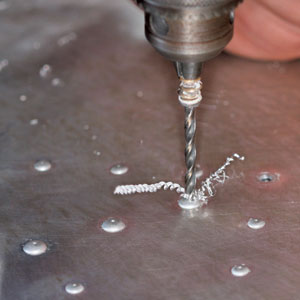
High-speed (twist) drills, the dimple in the head of AD rivets and practice are the keys to drilling out solid rivets.
Riveting Rules
The most common solid shank aluminum rivets used for aluminum airplane construction and repair are AN 470 (universal head) and AN 426 (countersunk head) rivets in 3/32, 1/8 and 5/32 diameters. Structural rivets have an AD suffix such as AN 470 AD. The two numbers following the AD suffix are shank diameter in 1/32-inch steps and length in 1/16-inch steps. An AN 470 AD 4-7 is a universal head rivet with a 1/8- (4/32-) inch shank that’s 7/16 inch long. An AD rivet has a dimple molded into the head. Rivets with no head markings are soft and are used only when riveting composite materials such as ABS plastics to aluminum structures.
Suggested bucking bar weights are 2 to 3 pounds when bucking 3/32-inch diameter rivets, 3 to 4 pounds when driving 1/8-inch diameter rivets and 3.5 to 4.5 pounds when driving 5/32 rivets. If lighter bars are used the rivets won’t swell to fill the hole, and the rivets’ tails will tend to crack due to work hardening.
Holes for solid rivets, and for Cherry N and Avex brand blind rivets, are drilled using a #40 drill for a 3/32-inch shank rivet; a #30 drill for a 1/8-inch shank rivet, and a #21 (or #20) drill for a 5/32-inch shank rivet. These drills cut a hole that’s slightly larger than the rivet shank (during the bucking and pulling operation the rivet shank swells to completely fill this larger hole). High-speed (HS) twist drills cost more than carbon-steel drills, but they last longer and are worth the extra expense.
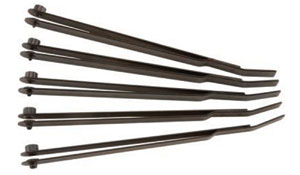
Hole finders are used to align and drill rivet holes in metal sheet replacements with existing holes. Each finder has a drill-guide bushing sized to accommodate a #10, #21, #30 or #40 drill. They are sometimes called hole or strap duplicators.
If a hole is deformed or drilled slightly oversize, oversize shank solid rivets can be installed. This sheet-metal trick preserves the appearance of the rivet line because the visible evidence of the repair (the rivet heads) is the same size for both standard and oversize shank rivets. This method isn’t an option with blind rivets. Any hole that isn’t a tight fit to the shank of a blind rivet must be drilled up to accommodate installation of the next larger diameter shank rivet.
One reference book says that if the top skin is thicker than the head of the rivet, it can be countersunk; skin the same thickness as the head of the (countersunk) rivet can be countersunk or dimpled; skin thinner than the head must be dimpled.
Removing Riveted Panels
Panel replacements require patience, skill and the correct tools to remove the existing rivets without either enlarging the holes or distorting the existing supporting structure. When removing rivets, an ounce of prevention is worth a couple of pounds of cure.
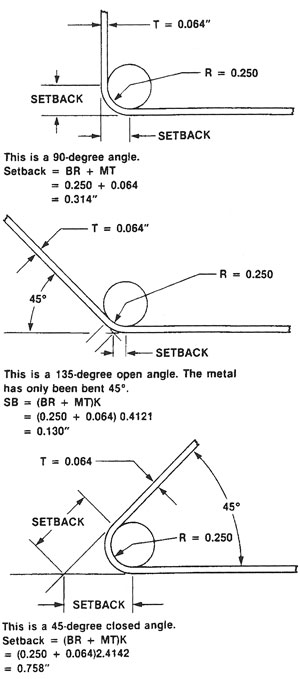
These examples illustrate setback, and how setback distances vary with bend angles.
Let’s take two examples. In Part 1 I wrote that Zenith Air supplies Cherry N-type blind rivets with its kits. That was incorrect; it uses Avex brand aluminum shell, steel stem-pull-type rivets. The most common way to remove these rivets is to use a pin punch to tap the steel stem back out of the shell body, and then use the same size drill (#30, #40, etc.) employed to drill the hole to drill the head off of the rivet.
Sonex uses stainless shell, stainless stem Cherry N rivets. The procedure for removing this rivet is to use an HS drill that’s the same size as the hole; rotational speed should be low while you apply medium pressure. If the drill catches and the rivet begins to rotate, stop drilling and use a pair of side-cutting pliers to hold the head and keep it from rotating. You may need to grind off a portion of the pliers’ jaws to get a good grip on the head. Using a lubricant such as cutting oil or turpentine improves the efficiency of the drills. Experiment with pressure and speed until you end up with a curly ribbon of metal.
Fabricate a New Panel
If the kit manufacturer can’t supply a new panel, a replacement can be fabricated. If the damaged panel can be bent back to near flat, it may be used as a cutting and rivet hole template. Many sheet-metal specialists prepare a metal cutting template using thin cardboard that’s been laid over the supporting structure and cut to fit. This cardboard pattern is then transferred to new sheet metal. A number of rivet hole locations can be picked up from the damaged (and now removed) skin. Clamp the removed and new skins together before drilling the new part. If it’s not possible to accurately locate every hole, hole duplicator (finder) tools can be used. These tools enable the builder to accurately drill new holes in new panels by locating holes in the existing structure. They are available at aircraft tool stores.
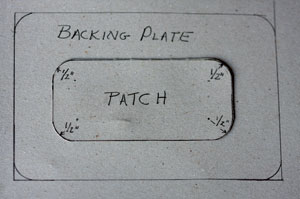
These thin cardboard templates are used to help determine whether there is sufficient access to both position and rivet the patch, and what backing plate size is needed to restore the panel to design strength.
After drilling, deburr each hole, dimple and/or countersink as necessary, clean and paint the non-exposed parts of the new panels and exposed structure, and Cleco the part in place before riveting.
The artistry and technical challenges involved in sheet-metal repair work is engrossing and stimulating. A well-done repair or skin replacement is a source of great satisfaction for builder/owners.

![]()
Steve Ells is what you call a gen-u-ine mechanic, a bonafide A&P with an Inspection Authorization. Former West Coast editor for AOPA Pilot and tech guy for the Cessna Pilots Association, Ells has flown and wrenched on a wide range of aircraft. He owns and wrenches (a lot!) on a classic Piper Comanche. But don’t hold that against him.

